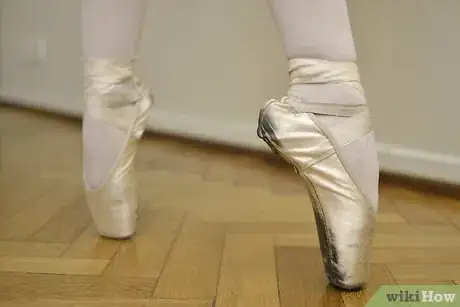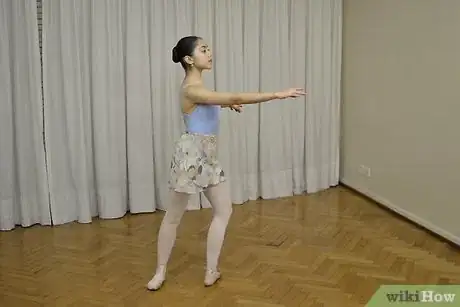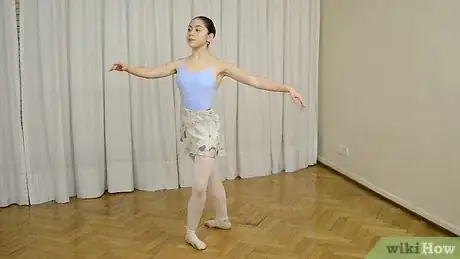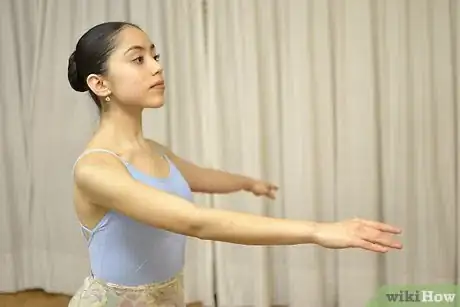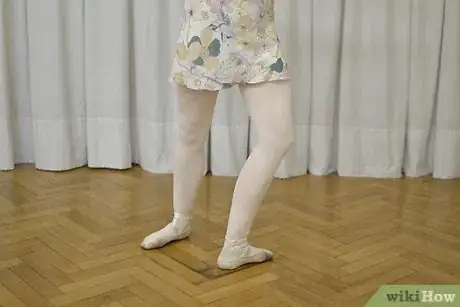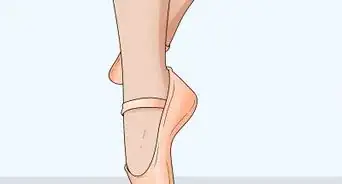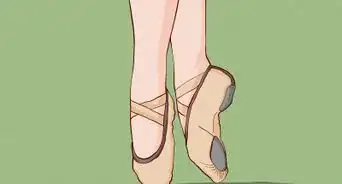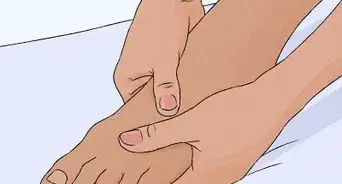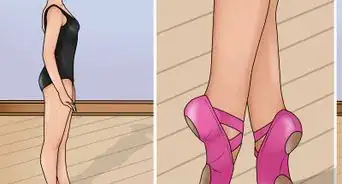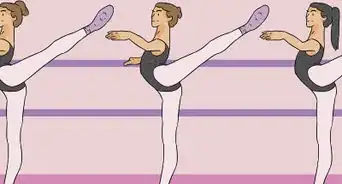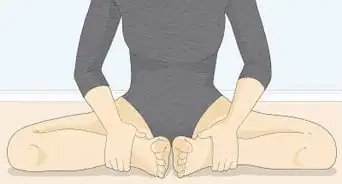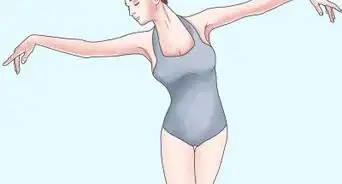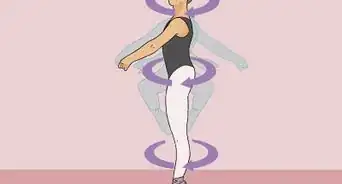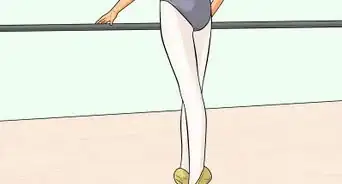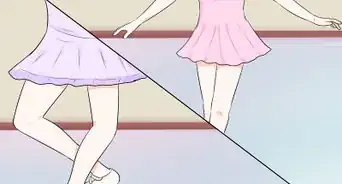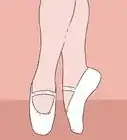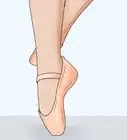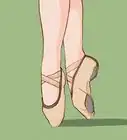This article was co-authored by Geraldine Grace Johns. Geraldine Grace Johns is a Professional Ballerina and the Owner of Grace Ballet in New York and Los Angeles. Geraldine toured through New Zealand, Australia, Japan, and Korea as Jammes in Ken Hill's Original Phantom of the Opera. She has studied with the Royal Academy of Dance in London to become a teacher and taught for the Kudo School of Ballet in Yokohama. Geraldine also ran her own Royal Academy of Dance School in New Zealand before studying at the Neighborhood Playhouse School of the Theatre in New York City. Geraldine was a guest coach and Master Class teacher in Toronto for the Canadian Royal Academy of Dance's Dance Challenge in 2018, 2019, and 2020. She was also a guest coach and Master Class teacher for the USA Royal Academy of Dance Challenge in Long Beach, California in 2019 and 2020. Grace Ballet Los Angeles has won recognition as one of 13 Best Ballet Schools in Los Angeles since opening her school. Geraldine is a contract Practical Teaching Supervisor for the Certificate in Ballet Teaching Studies for the Royal Academy of Dance.
There are 7 references cited in this article, which can be found at the bottom of the page.
wikiHow marks an article as reader-approved once it receives enough positive feedback. This article received 12 testimonials and 91% of readers who voted found it helpful, earning it our reader-approved status.
This article has been viewed 387,420 times.
The pirouette is one of the most classic moves in dance. By learning the proper positioning and form to execute a turn, beginners and dancers can learn how to perform a pirouette like a trained dancer.
Steps
Learning Proper Position
-
1Wear the appropriate footwear.[1] Ballet slippers, jazz shoes, turning shoes, are best for practicing pirouettes. You need something with good range of motion and support. Modern shoes, such as Capezio Foot Undeez or Dance Paws are also appropriate, which cover and support the ball of your foot. They're easy to slip on and great for quick practices.[2]
- You also need to practice pirouettes in a safe place, clear of any sharp objects or obstacles. It's always preferable to practice in a dance studio under supervision.
-
2Practice your retire position before you turn. Your retire position should be perfect before you begin to turn, making it important that you learn to place your toe correctly and bend your knee appropriately.[3]
- Place your toe into the notch at the top of the front of your knee, staying careful not to over-cross the foot on the leg. You should feel support under your thigh, when you're positioned properly.
Advertisement -
3Keep your ribs closed and your shoulders back. Your shoulders should be directly over your hips. Straighten your supporting leg to keep your releve should be as high as possible, imagine yourself stretching up to the sky, and into the ground.[4]
-
4Check your hips. Make sure your hips are not tilted to the back, or otherwise off-kilter. Imagine your hips were a fruit bowl. Would your fruit spill? A tilted pelvis can often lead to incorrect turns and eventually knee and back problems.[5]
- Make sure you have a strong plie prep but don't stay in your preparation (plie) too long, because then you will lose the momentum, making it difficult to pirouette.
-
5Arrange your feet in fourth position. If you are turning to the right, your left foot will be in front, with your weight evenly distributed between both feet so that you can push off the back foot.[6]
-
6Position your arms. Hold your right arm curved in front of you. Your palm should be facing your body with the elbow gently curved to the side, your arms rounded and out from your body as if holding a beach ball. Your fingers should be about level with the bottom of your rib cage. Keep your shoulder back.[7]
- Hold the other arm out to the side, palm forward and slightly below the shoulder. Keep the elbow in front of your body.
Executing the Turn
-
1Bend your knees and push off the back leg. You should move into retire position on releve. At the same time, close your left arm into first position and bring the left side of your back around.[8]
- Make sure, while turning, you keep your hips stacked under your shoulders, there should be no curve in your spine. This will ensure better balance.
-
2Point the retire foot hard. Imagine you're bringing that retire higher as you turn. This will also keep your center up and balanced. Make sure your foot is still connected to your leg.[9]
- Keep your supporting leg nice and straight, and don't sickle your feet. Sickling means that you let your ankle slouch and you lose your balance. Also remember to spot, so you don't get dizzy. Don't try double or triple pirouettes if you can't get a single down.
-
3Focus on going up, not around. Imagine someone is pulling you by a string on the top of your head. The turn will come naturally when you learn to go up. Focusing too hard on the spin causes inexperienced ballet dancers to tilt slightly, losing balance. Focus instead on going up and nailing the mechanics of the turn.
-
4Spot yourself during the turn. As you are turning, look at a spot on the wall level with your eyes and as you rotate, attempt to keep it in sight at all times, you'll have to whip your head around to find it again with each rotation.[10] This is called spotting.[11]
- Stop and return to fourth position. Your feet should be placed in the same position they were when you started.
-
5Modulate force for number of rotations desired. Before attempting multiple turns, try to balance at the end of a single turn before landing. More force generally equals more rotations, but it is also a timing thing. Too much force will send you careening across the room and you will lose control. Equally, too little power and you'll stop dead in your tracks and fall face first. The proper amount of power comes with experience and you'll soon be able to tell whether you have too much power or not enough.
- For the first few tries, only attempt a single pirouette to familiarize your body with the feeling and motion. It takes time to work up to a double, triple, or a quad. You may even want to start with only quarter/half turns. If you try doubles/triples right away you will be disappointed.
-
6Stick with it. Remember, every ballerina has fallen on a pirouette at least once. Practice makes perfect. It doesn't take long to be able to do a pirouette and once you get the hang of it, it will feel natural.
Expert Q&A
Did you know you can get expert answers for this article?
Unlock expert answers by supporting wikiHow
-
QuestionHow can I improve my pirouette?
 Geraldine Grace JohnsGeraldine Grace Johns is a Professional Ballerina and the Owner of Grace Ballet in New York and Los Angeles. Geraldine toured through New Zealand, Australia, Japan, and Korea as Jammes in Ken Hill's Original Phantom of the Opera. She has studied with the Royal Academy of Dance in London to become a teacher and taught for the Kudo School of Ballet in Yokohama. Geraldine also ran her own Royal Academy of Dance School in New Zealand before studying at the Neighborhood Playhouse School of the Theatre in New York City. Geraldine was a guest coach and Master Class teacher in Toronto for the Canadian Royal Academy of Dance's Dance Challenge in 2018, 2019, and 2020. She was also a guest coach and Master Class teacher for the USA Royal Academy of Dance Challenge in Long Beach, California in 2019 and 2020. Grace Ballet Los Angeles has won recognition as one of 13 Best Ballet Schools in Los Angeles since opening her school. Geraldine is a contract Practical Teaching Supervisor for the Certificate in Ballet Teaching Studies for the Royal Academy of Dance.
Geraldine Grace JohnsGeraldine Grace Johns is a Professional Ballerina and the Owner of Grace Ballet in New York and Los Angeles. Geraldine toured through New Zealand, Australia, Japan, and Korea as Jammes in Ken Hill's Original Phantom of the Opera. She has studied with the Royal Academy of Dance in London to become a teacher and taught for the Kudo School of Ballet in Yokohama. Geraldine also ran her own Royal Academy of Dance School in New Zealand before studying at the Neighborhood Playhouse School of the Theatre in New York City. Geraldine was a guest coach and Master Class teacher in Toronto for the Canadian Royal Academy of Dance's Dance Challenge in 2018, 2019, and 2020. She was also a guest coach and Master Class teacher for the USA Royal Academy of Dance Challenge in Long Beach, California in 2019 and 2020. Grace Ballet Los Angeles has won recognition as one of 13 Best Ballet Schools in Los Angeles since opening her school. Geraldine is a contract Practical Teaching Supervisor for the Certificate in Ballet Teaching Studies for the Royal Academy of Dance.
Professional Ballerina & Ballet Instructor
-
QuestionHow do I turn without getting dizzy?
 FantasticforeverCommunity AnswerIn order to turn without getting dizzy, you must spot something. What this means is that you look at your eyes in the mirror or spot something in front of you with your eyes and hold it there as long as you can and then snap your head around.
FantasticforeverCommunity AnswerIn order to turn without getting dizzy, you must spot something. What this means is that you look at your eyes in the mirror or spot something in front of you with your eyes and hold it there as long as you can and then snap your head around. -
QuestionHow can I perform multiple pirouettes?
 Community AnswerTo perform multiple pirouettes, you need to practice. Start with one pirouette, and keep doing it until you do it perfectly. Once you have the technique down, you should be able to do two or even three in a row. Remember to spot and to keep everything tight; this will help with balance.
Community AnswerTo perform multiple pirouettes, you need to practice. Start with one pirouette, and keep doing it until you do it perfectly. Once you have the technique down, you should be able to do two or even three in a row. Remember to spot and to keep everything tight; this will help with balance.
Warnings
- Pets, spouses, children, breakable objects, power tools, automobiles, sharp objects and pride all can be wounded in the attempt. Adjust accordingly.⧼thumbs_response⧽
- Always use an open area so if you fall you won't crash into anything.⧼thumbs_response⧽
- Don't pirouette on carpet.⧼thumbs_response⧽
Things You'll Need
- Proper clothing: Clothes you are comfortable wearing and can move easily in, whether this is a leotard or your pajamas. A dress probably won't work and neither will jeans.
- Large open area: You'll feel better and ultimately be able to do a better pirouette because you won't have to worry about running into anything.
References
- ↑ Geraldine Grace Johns. Professional Ballerina & Ballet Instructor. Expert Interview. 11 November 2020.
- ↑ http://school.ballet58.org/blog/2015/10/27/dance-shoes-explained
- ↑ https://ballethub.com/ballet-lesson/positions-passe-retire-basics/
- ↑ https://www.energetiksblog.com.au/blog/2017/6/7/dance-advice-the-art-of-pirouettes
- ↑ https://www.energetiksblog.com.au/blog/2017/6/7/dance-advice-the-art-of-pirouettes
- ↑ https://www.energetiksblog.com.au/blog/2017/6/7/dance-advice-the-art-of-pirouettes
- ↑ https://www.energetiksblog.com.au/blog/2017/6/7/dance-advice-the-art-of-pirouettes
- ↑ https://www.adult-ballet.org/pirouettes/
- ↑ https://www.adult-ballet.org/pirouettes/
- ↑ Geraldine Grace Johns. Professional Ballerina & Ballet Instructor. Expert Interview. 11 November 2020.
- ↑ https://www.youtube.com/watch?v=8fFi2YHmAlc&feature=emb_logo
- Videos provided by Kathryn Morgan
About This Article
To do a pirouette, start with your feet in fourth position and your arm curved in front of you with your palm facing your body, as if you were holding a beach ball. From this starting position, bend your knees and push off your back leg while bringing your left arm in front of you to start turning. Then, keep your grounded foot pointed firmly and your ankle straight as you rotate to help you keep your balance. Finally, to end the pirouette, return your feet to the same position in which you started. For tips on how to work your way up to multiple rotations, read on!
